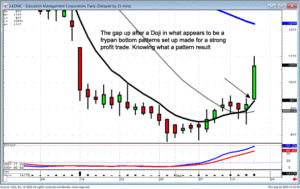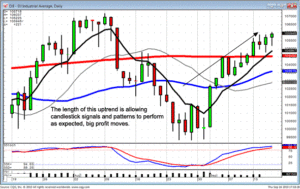Companies selling commodities often engage in hedging in order to contain their investment risk. Gold mining companies will sell gold futures and agricultural cooperatives will sell corn futures or engage in live cattle commodity trading. By selling commodities as futures a company guarantees itself a certain level of profit no matter what the spot price of the commodity might be in a given length of time. Likewise processors of commodities will buy commodity futures in order to guarantee the commodity price for the next season or next year. Users of energy products such as aviation fuel will often hedge the risk of rising prices by selling futures. If the price of petroleum products goes up the company will offset its higher fuel costs with profits from trading. Likewise the company may simply buy futures in the commodity and take delivery at the contract expiration date. Commodity and futures training will give those beginning commodity futures trading a clear idea of how buying and selling commodities works.
An alternative to buying or selling commodities futures is commodity options trading. By buying puts, traders will obtain the option but not the obligation to buy a commodity futures contract at a set price. The trader will pay a premium for the options contract. However, if the commodity price does not move as expected the trader is under no obligation to execute the trade and the only cost of the experience will be the premium. If, on the other hand, the commodity futures price moves as expected the trader can execute options contracts, selling commodities at the higher price while simultaneously buying at the new, lower price.
To profit from selling commodities futures the trader will do both fundamental and technical analysis on a commodity. This will involve following production reports, crop reports, weather reports, or economic reports, depending upon the commodity traded. It will also involve reading market price patterns. Fundamental analysis can be very rewarding if the trader discovers information before the rest of the market but, usually, the results of fundamental commodity analysis are known to all traders and are only useful as a guide to market limits. The daily price movements of commodities markets are best anticipated with tools such as Candlestick patterns.
By analyzing Candlestick pattern formations the trader will be able to make use of the fact that commodity markets repeat themselves and that reading the first half of a pattern correctly helps to profitably predict the second half.
Traders have been using Candlestick basics in buying and selling commodities for more than three centuries. The basics of this easy to read, visual, system evolved in rice trading in ancient Japan. However, Candlestick analysis is applicable to all commodities trading as well as stock trading and options trading. The Candlesticks system works because it lets the market tell the trader what the market will do. As in all trading there is risk. However, the trader who can more accurately anticipate commodity price movement will more likely profit in buying and selling commodity futures.
Market Direction
Why is it important to know the simple rules for candlestick signals and patterns? It prepares an investor to take advantage of high profit situations immediately! Because there are expectations after witnessing a signal or a pattern, an investors trading strategy for their next swing trade or day trade can be put in place with a high degree of profitable results. This is clearly illustrated in the EDMC chart. The visual recognition of a frypan bottom patterns set-up made for a very profitable trade. The simple rules for this pattern allowed for a very obvious profitable trade.
Where is a Frypan bottom patterns usually going to breakout? When the stochastics are close to the overbought condition! This is the result of investor sentiment slowly building up in a positive trend.
Yesterday, EDMC formed a Doji/spinning top right on the T-line. There was nothing unusual about this other than it was continuing the trajectory of a frypan bottom pattern. However, today’s open indicated a strong buying force. It gapped up. What is the simple analysis of the situation? A frypan bottom has been developing. A Doji formed on the tee line. The Doji was followed by a gap up on the open. What is expected for a frypan bottom breakout? Either a very big bullish candle or a gap up, or in this case a combination of both. This is not rocket science. This is merely taking advantage of what investor sentiment usually does time after time.
Patterns have an opportunity to form to completion when the market starts showing a consistent trend move. As seen in both the Dow and the NASDAQ, the uptrend has been consistent ever since September one. This has allowed investor sentiment to build up, making candlestick patterns work effectively. Today’s trading in the markets indicated profit-taking most of the day but the buying continued eventually going into the close. The indexes are trading at or near obvious resistance levels. What should be expected once they get to those levels? This is where knowing what candlestick signals represent provide an immense amount of information.

EDMC

DOW
There has been good profits made in this last market move. Have all the recommendations made profits. Definitely not, but knowing how to apply candlestick analysis to your portfolio makes closing out the unprofitable trades quickly and anticipating where the next strong price moves may occur. For those of you that are fairly new to candlestick analysis, you will find there is a completely different perspective on how to make profits. The assumptions attached to candlestick analysis are not one of speculation, they are utilizing the information built into graphic chart formations that have demonstrated what the candlestick signals and patterns are representing.
If you have not had the opportunity to participate in the two day candlestick training course, please think about this seriously. When you see all the common sense aspects of candlestick analysis put into a logical order, you begin to have a completely different perspective on how to make profits in the markets. You will know when to be buying and you will know when to be selling. Steve Bigalow demonstrates the powerful implications that are revealed through the candlestick signals. He will teach you in a manner that allows you to immediately look for and take advantage of profitable trades.
Chat session tonight at 8 PM ET. Everybody is welcome.
Good Investing,
The Candlestick Forum Team
E-Learning Online Training Schedule
Options Training Course
October 16 & 17, 2010
Commodity Training
November 6 & 7, 2010
Boot Camp
November 20 & 21, 2010
Website special reflects current newsletter. If you are reading an archived newsletter you will be directed to the Current Website Special
Speak Your Mind